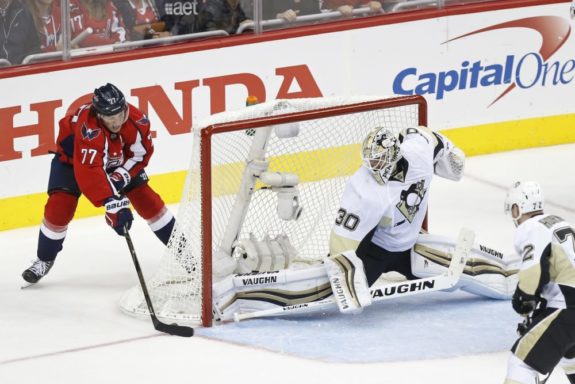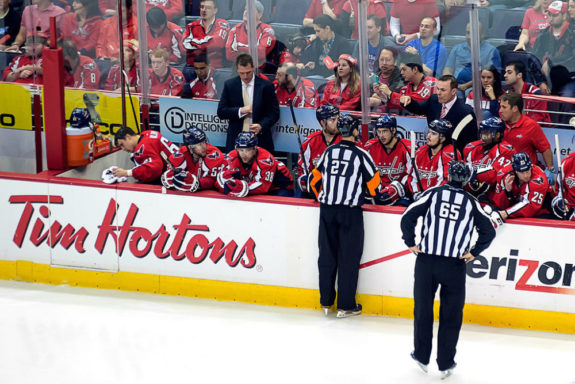If Game 2 of the Washington Capitals versus Pittsburgh Penguins series taught us anything, it was that there is still no conclusive ruling on what a controversial goal is or is not.
Penguins’ Controversial No-Call
In a game where the Capitals took a quick three-goal lead just minutes into the second period, Pittsburgh’s comeback bid with just over 10 minutes to play in the third frame was underway—or at least everyone thought it was. Sidney Crosby’s wraparound generated a rebound off of Braden Holtby’s left pad near the post while a net-driving Patric Hornqvist followed up the play and appeared to shovel the puck just inside the right post and across the goal line. With Crosby, Hornqvist and the rest of the Penguins celebrating, the call on the ice was actually no goal.

After many different camera angles were shown to the viewers, it was evident that body parts, sticks, and compiled snow were affecting the decision altogether. There was one camera angle that was zoomed in to the point in which one could argue that the puck was across the goal line, but it was not a full guarantee by any means. The final verdict was that there was inconclusive evidence to overturn the call on the ice, and it stood as called – no goal.
What Does the NHL Rule Book Say?
Rule 78.4 in the Official NHL Rulebook states that, “A goal shall be scored when the puck shall have been put between the goal posts by the stick of a player of the attacking side, from in front and below the crossbar, and entirely across a red line the width of the diameter of the goal posts drawn on the ice from one goal post to the other with the goal frame in its proper position.”
Rule 78.6 pertains to video review. This rule states, “When a team scores an apparent goal that is not seen by the on-ice officials and play continues, the play shall be reviewed by the Video Goal Judge at the next stoppage of play. If the goal is confirmed by video review, the clock (including penalty time clocks, if applicable) is re-set to the time the goal was scored. If the goal is not confirmed by video review, no adjustment is required to the clock time.”
So, regarding the Hornqvist no-goal call, the proper action clearly took place. In this case, the referee got it right, according to the rule, as there was insufficient evidence to overturn the call on the ice.
History of NHL Playoff Controversial Calls
This was not that first time that there has been a controversial call in a crucial moment of a playoff game. A similar type of play in overtime of Game 1 of the 2016 Stanley Cup Playoffs‘ second-round between the Penguins and Capitals saw Washington forward T.J. Oshie wrap the puck in on the left side of the net. Goaltender Matt Murray stretched to make the save and, once again, the puck sat near the left post and Murray’s right pad. This time, though, the call on the ice was a good goal. Upon video review, there simply was not enough evidence to overturn the call.

For Calgary fans and Canadian citizens who have been waiting since 1993 for the Stanley Cup to be brought back home, there has not been a worse call than the 2004 Stanley Cup Finals Game 6 overtime no-goal call on Martin Gelinas. Obviously, technology has improved in the past decade, but video clearly demonstrated that the puck fully crossed the goal line before hitting the pad of Tampa Bay Lightning goaltender Nikolai Khabibulin. At the time, the NHL used clip-by-clip review technology to determine a goal, which had an impact on the overall decision.
The argument now becomes, should the NHL implement goal-line technology on the ice as we have seen in other professional sports?
Hawk-Eye Technology Would Benefit the NHL
In professional sports such as tennis, volleyball, cricket and other sports where sidelines are a pivotal component of the game, Sony created the Hawk-Eye computer system in 2006. This system has several cameras placed under the roof of a sporting arena that track the ball from various angles. It is most famously seen in the ATP Grand Slam tournaments in which each player can ask the umpire for a review if they believe the call on the court was inaccurate. The Hawk-Eye system is not perfect, but evidence proves that it comes to within roughly three millimeters of being accurate.
This technology system is something that the NHL should strongly consider in 2019. Not only would this take the majority of the responsibility out of the referees’ hands, or Toronto’s Control Room for that matter, but it would speed up the game significantly. As we have seen in the past, the game is filled with controversy. That is the of nature sports, but when the cameras inside the net are blocked and the overhead cameras views are obstructed, then the Hawk-Eye system would come in handy.
A similar type of goal-line technology was implemented in FIFA as well. FIFA has gone so far as to place magnetic field systems underground and beneath the goal line. The magnetic field uses receptors that determine if the ball has fully crossed the goal line, while the underground cables can determine the exact positioning of the ball. FIFA referees get an alert within seconds and continue the flow of the game. Sure, there have been many times in which a player is obstructing the view and the magnetic field cannot pick up the sensors, but by adding more camera angles to the field of play would actually speed things up even further.
NHL Goal Review Issues
As mentioned before, the biggest issue surrounding a controversial call is actually being able to see the puck completely cross the goal line. For Pittsburgh’s case, one could argue that you could see a thin strip of white ice between the goal line and Holtby’s pad from the center ice camera; however, side camera angles tend to display optical illusions as opposed to an overhead view. By implementing a similar type of overhead view like the Hawk-Eye, along with multiple cameras working together to generate a near perfect conclusion, the NHL could be impacted in a positive way going forward.

Controversial goals happen on a weekly basis and typical NHL replay will generally determine the correct call. However, in the odd case in which we do end up with a controversial goal decision in a meaningful playoff game, the type of Hawk-Eye technology or magnetic sensors would not only speed up the game, but it would get the call right without creating an overwhelming discussion about whether or not the referees ruled it correctly.